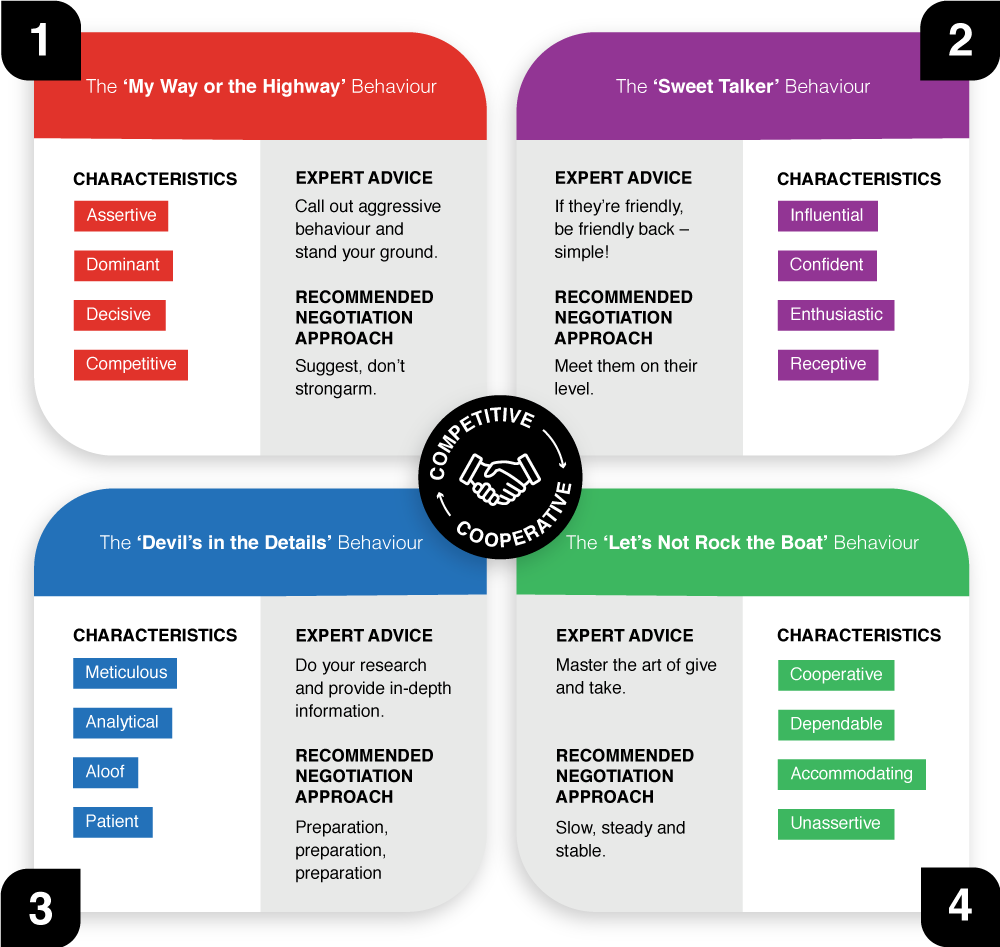

Life is full of negotiations, from high-stakes business arrangements to buying a property or even settling a dispute between family members. The good news is, by learning how to communicate effectively and adapt your approach, you can learn skills which can help you forge better business relationships, gain more control over financial transactions, and reap the rewards of democratic bargaining.
With the professional advice of leadership, negotiations and communications expert Denise Louise Jeffrey, we’ve produced a comprehensive guide to getting what you want, including pointers on tailoring your approach to the different behaviours you may be faced with. With 17 years’ experience hosting seminars, keynote speeches and coaching, she has helped many clients accelerate with efficient negotiation and leadership skills.
Below you can find some of her key teachings.
Preparing for your negotiation
To begin your discussion with the most suitable tack, you must know who you’re negotiating with and what kind of behaviour they’re exhibiting. Negotiation isn’t a case of one size fits all, and what works for one person may not work for the next.
“When preparing for a negotiation one has to understand what each party is hoping to get out of the meeting,” explains Denise.
“Be prepared to negotiate with an outlook of achieving different outcomes that could be acceptable for all parties, depending on the style of bargaining your counterpart pursues.”
It’s a common misconception that negotiation is all about an individual’s personality. In actual fact, everyone has the capability to alter their behaviour according to their environment regardless of personality, meaning everyone can learn how to become a great negotiator.
Looking at four archetypal behaviour types, commonly observed within negotiation settings, we’ve outlined how to recognise each of the behaviours and the best way to proceed in a transaction with people exhibiting each characteristic.

1. 'It’s my way or the highway'
Key characteristics: dominant, assertive, decisive and competitive

Somebody exhibiting the 'it’s my way or the highway' behaviour will be motivated by getting their way – and they don’t care at what cost this comes or what the long-term ramifications may be.
“There’s no doubt that somebody showcasing this behaviour is in it to win it. A hard nut to crack, they’ll enter the meeting with a resolute idea about how they want it to pan out and will be prepared to fight their ground if necessary,” says Denise.
This may resonate with you if you have a boss who is never wrong or an obstinate client with a thirst for the upper hand.
How to negotiate with them:
It’s a common misconception that somebody displaying this kind of behaviour simply can’t be negotiated with, but this isn’t necessarily true, you just need to go about it tactfully, with a cool head.
Denise recommends that the best thing you can do when faced with this kind of dominant behaviour during a discussion is to flag it up.
“You should always be professional and polite, but you should also always call out that behaviour, because people who negotiate in that aggressive way are being unprofessional, and you’re not calling them out as a person, you’re calling out their behaviour,” she says.
“If they react poorly, you should put off the negotiation and revisit it at a time when everyone is in the right mindset. It’s polite, but it’s your way of saying ‘we’re not moving forward like this.’”
“What you shouldn’t do is come across as weak, as you’re putting yourself at risk of them walking all over you. Be assertive, but without strong-arming them – this is likely to end in conflict. Instead, make firm suggestions and back them up with strong, fact-based reasoning that can’t be argued against.”
A famous example:
Denise suggests that a famous example of somebody who has demonstrated this behaviour during a negotiation is Margaret Thatcher.
She describes this as “both her strength and weakness, which ultimately cost her the leadership of her own party and gave her the nickname ‘The Iron Lady’.”
2. 'Sweet-talker'
Key characteristics: receptive, cooperative and influential

We’ve all come across somebody like this at one point or another – they’re so charming and charismatic, you feel like you’ve made a friend for life within five minutes of meeting them.
If you enter a negotiation with a “sweet-talker”, it’s likely they’ll get you on side with conversation about friends, family and life beyond work. While it’s possible they’re legitimately just a friendly person, forming a personal connection with a client can be used as a powerful persuasion tool within a negotiation setting.
How to negotiate with them:
Maintaining or forging long-term relationships is important to them, and therefore they will be seeking a win-win outcome, where all parties walk away from the table happy.
“This is probably the easiest type of behaviour to respond to when striking a deal, as it indicates that the person wants to keep it harmonious. It’s only human nature that if somebody is nice to us, we feel inclined to be nice back,” explains Denise.
Mirroring the other person’s behaviour is the best way to get a favourable outcome in a settlement.
“If somebody is cooperative and receptive at the negotiation table, you want to mirror this behaviour, because you’ll get the best results and most respect.”
Famous example:
A high-profile example of somebody known to adopt this negotiation behaviour is Richard Branson, famous for his charismatic leadership style.
Denise, who once worked for Branson’s former record label Virgin Records, describes Branson as a ‘pro at negotiating,’ elaborating that, “he knows how to use charm and very rarely takes no for an answer. He influences his counterparts with his enthusiasm and his receptive attitude to new ideas.”
3. 'Let’s not rock the boat'
Key characteristics: cooperation, dependability and compliance

In a similar vein to the 'sweet-talker', "let’s not rock the boat behaviour signifies that the individual wants to keep the relationship intact," says Denise.
"This is particularly common when entering a negotiation with a long-term client or somebody with whom there is already a relationship of value,” Denise clarifies.
How to negotiate with them:
This pre-existing relationship with the person you’re negotiating with is both a blessing and a curse.
“You know what they’re like as a person and can, therefore, predict how they may behave in the meeting; however, it means you need to adopt a soft approach in order to maintain good relations.”
Denise recommends that in this scenario you have to adopt a slow and steady manner and master the give and take.
“You’re at an advantage by knowing each other, so you’re able to know what would benefit them that you can give them, and what you could benefit from that they can provide.”
A famous example:
An example of this that Denise flagged would be when the US Government was negotiating with North Korea for the return of captured prisoners of war during Operation Homecoming. The US government had to come across as cooperative and accommodating to achieve the outcome of their negotiations.
4. 'Devil’s in the detail'
Key characteristics: meticulous, analytical, and patient

Frequently a type of behaviour manifested among perfectionists, the 'devil’s in the detail' demeanour is characterised by a sharp attention to detail and fact-based information.
Shedding some more light, Denise says: “the individual will want everything backed up by facts, and like a poker player, it’s likely they won’t show any emotion. Though they may come across as calculating and cautious, in the long run they want to come to an agreement that benefits both parties.”
You know the one we’re talking about – every suggestion must be backed with ‘how?’ and ‘why?’ They’re a stickler for detail and they want to build a full picture on the subject before any decisions can be made.
How to negotiate with them:
To achieve the best possible outcome in a negotiation with someone showing this behaviour, the key is to make sure that you’re thoroughly prepared and can answer any questions that may be thrown your way.
“Know what they respond best to – for example while the sweet-talker responds best to a sociable setting and a more summarised approach to information, someone who is detail-orientated will respond better to an in-depth ‘encyclopaedia’ of knowledge.
"If they enter the negotiation with lots of data-backed information, make sure that you can provide the same.”
It’s all about tailoring your approach. If they’re all for the detail, they don’t want integral information to be communicated in a simplified visual manner.
Famous example:
“One of the most notable negotiators who adopted this style was Nelson Mandela – though it’s worth recognising that he rarely stuck to one negotiation style, as he believed this would be restrictive,” teaches Denise.
“He demonstrated this technique when negotiating with the South African apartheid government – he understood when to make concessions for the greater good and when to be uncompromising with his political beliefs.”
What can be learnt from the advice provided by Denise, and by looking at the psychology of negotiations in more depth, is that the fundamental rules of successful bargaining are adaptation and communication.
According to Denise, the most valuable skill a negotiator can possess is “being able to adapt and negotiate in all styles – not just the one you are most comfortable with."
"This often includes integrating more than one style of negotiating at a time.”
There’s a lot of psychology involved in a negotiation, and simply asking for what you want probably won’t cut it when it comes to finalising an agreement that both parties are happy with. To achieve the best outcome, you must read their behaviour and tailor your approach accordingly.
To maintain a positive client relationship and ensure that negotiations remain between two parties that have respect for each other, take the necessary precautions to protect both your businesses against common risks.
Comprehensive insurance may already be required as part of your working contract to protect both your interests in the event of an error or accident.
The key covers to consider are public liability insurance, to protect the business from risks such as injury or property damage caused by business activities; and professional indemnity, which provides cover if a client is unhappy with the work you’ve done or advice you've offered.
Want to know more? You can find the Hiscox introduction to public liability and a full definition of business indemnity cover by following the links.
For more expert advice from Denise Louise Jeffrey on how to get the most out of your business negotiation, visit her website (external link).
Disclaimer:
At Hiscox, we want to help your small business thrive. Our blog has many articles you may find relevant and useful as your business grows. But these articles aren’t professional advice. So, to find out more on a subject we cover here, please seek professional assistance.






